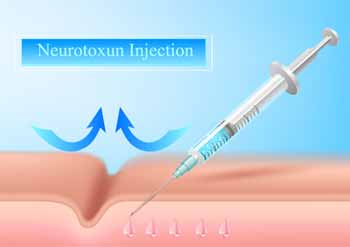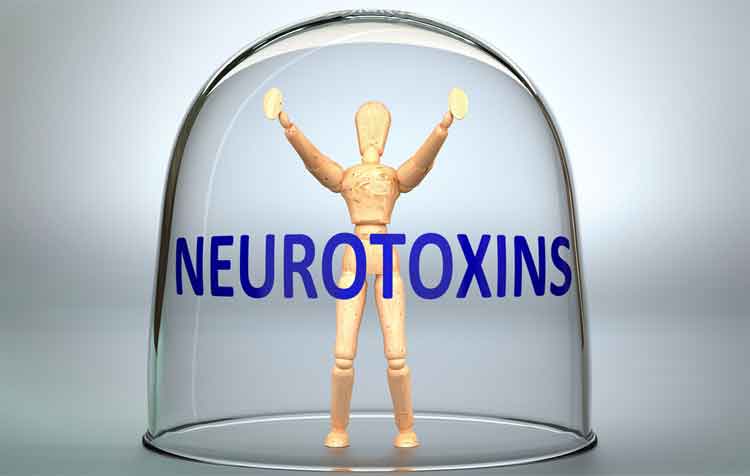Certain foods are more dangerous to eat than others. Pufferfish, for example, is a delicacy in parts of Asia, yet is practically untouched elsewhere.
Why is this? It is because pufferfish, while alive, have bodies filled with neurotoxins, and only if cooked appropriately are they safe (otherwise they can be very deadly).
What are Neurotixins?

The name itself is rather frightening; a toxin which affects the neurological system (that is, the system which revolves around the brain).
The particular toxin in pufferfish, called tetrodotoxin, has a peculiar habit of making its way through the body, shutting off the electrical signals sent by nerves (causing numbness, usually beginning in the mouth and then spreading, depending on the severity of the poisoning).
Then, the toxins bind themselves to pores on sodium channels which send electrical current through the myocytes (the cells which cause muscles to contract), which inhibits muscles motion, effectively paralyzing the victim.
Fortunately, these toxins only really affect certain fast sodium channels, where the muscles of the heart are made of slow sodium channels, so the toxins have no effect on the heart. This is little consolation, however, as death often occurs from the paralysis of the lungs and a resulting collapse of the cardiovascular system while the victim is often entirely lucid, though paralyzed.
Is There a Cure?
There is no real cure for poisoning by tetrodotoxin, though there are treatments which possess varying degrees of effectiveness.
The most effective treatment involves emptying a victim’s stomach of its contents (that is, half-digested pufferfish or one of those even rarer animals which possess the same toxin), then forcing the ingestion of activated charcoal (a carbon-based product) which bonds with some of the toxins, preventing them to a certain extent from causing harm.
After this, the idea is really just to wait and see what happens. While upwards of 80% of those paralyzed by tetrodotoxin die within the first 24 hours, if a victim can make it longer than this, the odds are very good that they will make a complete recovery to full health as the toxins finally begin to flush from the system and the paralysis lessens, go to website.
Clearly, neurotoxins are not something which should be taken lightly, and don’t think for a moment that tetrodotoxins are the only ones. In fact, they may not even be the worst.
Batrachotoxin
While amongst some this might be open to debate, the worst neurotoxin most likely is Batrachotoxin.
This is the stuff that is most commonly found South American Poison Dart Frogs (well-respected as the most venomous vertebrate roaming the Earth today), which coats their entire colorful bodies, making them absolutely deadly even to the touch.
How much batrachotoxin does it take to kill a person? One hundred micrograms. An amount roughly the size of a couple grains of table salt.
It’s no wonder the Central and South American natives were known to rub their arrowheads with these frogs – it gives it that extra boost of deadliness that a normal arrowhead lacks.
So what happens when a person finds themselves having just accidentally ingested some form of batrachotoxin? Nothing good.
Like tetrodotoxin, this stuff quickly affects the body’s sodium channels, though unlike the pufferfish’s poison, batrachotoxin directly affects the heart muscles, causing severe symptoms which lead, more often than not, to a quick case of cardiac arrest. It’s quick, and perhaps even more pleasant compared to death by tetrodotoxin.
An Ironic Cure?
While no sure antidote has been discovered for batrachotoxin, there is a small ray of hope on the horizon.
It has actually been found that some positive effects may be gleaned from the application of tetrodotoxin, which acts as a non-competative inhibitor for the deadlier toxin.
In other words, these two neurotoxins might just act to cancel each other out! Such a treatment is still in the theoretical stages, but it’s interesting and ironic nonetheless.

A World of Neurotixins
Those are the basics of tetrodotoxin and batrachotoxin – two of the most potent toxins known to man.
They are not the only ones to be sure – they are just the ones which affect the body’s sodium channels. There are others, such as charybdotoxin (found in a certain type of scorpion) which affects the potassium channels and some such as calciseptine (found in the Black Mamba snake) which affects the calcium channels.
Indeed, there are about as many different types of neurotoxins as ice cream flavors at the grocery store… but you wouldn’t want to eat them.
In fact, it’s probably best to just let neurotoxins be.











 Blinged-Out Watches for Spring: Combining Luxe Touches With the Common for Fashionable Timepieces
Blinged-Out Watches for Spring: Combining Luxe Touches With the Common for Fashionable Timepieces